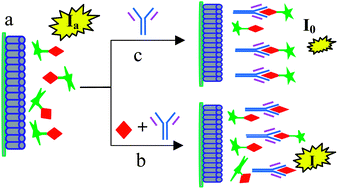Homogeneous electrochemiluminescence immunoassay based on tris(2,3-dibromopropyl) isocyanurate using luminol luminescence and Ti/TiO2 NTs electrode†
Abstract
A novel homogeneous

* Corresponding authors
a
State Key Lab of Chemo/Biosensing & Chemometrics, College of Chemistry & Chemical Engineering, Hunan University, Changsha 410082, China
E-mail:
qycai0001@hnu.cn
b Department of Chemistry, Industrial University of Ho Chi Minh City, Ho Chi Minh, Viet Nam
c Key Lab of Modern Preparation of TCM, Ministry of Education, Jiangxi University of Traditional Chinese Medicine, Nanchang 330004, China
A novel homogeneous

 Please wait while we load your content...
Something went wrong. Try again?
Please wait while we load your content...
Something went wrong. Try again?
L. Yuan, L. Zhou, J. Li, L. Shi, T. Tran.T, L. Chen, C. Huang, Z. Yan and Q. Cai, Anal. Methods, 2013, 5, 3626 DOI: 10.1039/C3AY40418H
To request permission to reproduce material from this article, please go to the Copyright Clearance Center request page.
If you are an author contributing to an RSC publication, you do not need to request permission provided correct acknowledgement is given.
If you are the author of this article, you do not need to request permission to reproduce figures and diagrams provided correct acknowledgement is given. If you want to reproduce the whole article in a third-party publication (excluding your thesis/dissertation for which permission is not required) please go to the Copyright Clearance Center request page.
Read more about how to correctly acknowledge RSC content.
 Fetching data from CrossRef.
Fetching data from CrossRef.
This may take some time to load.
Loading related content
